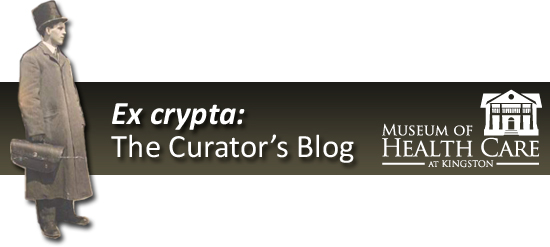Welcome to the Museum of Health Care’s first edition of Ex crypta: Curator’s Blog. Ex crypta (From the Vault) will feature periodic entries about artefacts in our collection, intriguing stories related to health care history, or details about ongoing projects or subjects I am pursuing. The Museum’s collection of objects and archival materials documenting the history of health and medicine in Canada contains many wonderful treasures. This blog is one way that we can share some of them with you. And of course, your questions and comments are welcome anytime.
Dr. Duffin recounted her years of intensive research in the Vatican archives and library into stories of illness, prayer, treatment, and miraculous cure described in detailed files documenting over 1400 miracles spanning four centuries from six continents. Beatification and canonization are the official process that the Roman Catholic Church uses to recognise men and women who are believed to have lived lives of outstanding holiness, inspired by the grace of God and the spirit of the Gospel and have since died. The Church’s examination of a cause for a particular saint can only be completed when one or more miracles attributed to the saint’s intercession with God can be established. Only supernatural events such as the sudden and irreversible cure of a serious disease are accepted as miracles.
Professor Duffin, who is the Hannah Chair for the History of Medicine at Queen’s University in Kingston, has had a long fascination with the interrelationship between medicine and religion and how each derives meaningful signs from particular instances of human distress. A haematologist as well as a historian, her research interest in medical miracles was sparked in the 1980s when she was requested to read a set of blood and bone marrow microscope slides without being told the reason why or any clinical details. Dr. Duffin concluded that the samples came from a patient suffering from acute leukaemia and who had gone into remission, not once, but twice. Given the information she could glean from the slides, Dr. Duffin assumed the patient had since died. She admits her surprise when she later learned that the patient was alive and attributed her cure to a miracle – the intercession with God of a Montreal woman, Marie-Marguerite d’Youville who had died in 1771. The doctor’s analysis of the blood samples became a deciding factor in the cause for Youville’s canonisation in 1990 as the first Canadian-born saint.
Dr. Duffin also expressed her surprise to learn from her research that about 95 per cent of the recorded miracles she read were connected with healings from physical sickness and that for most doctors provided testimony. The Church has long relied on the expertise of physicians in the canonisation process and respected the knowledge that modern medicine can provide. As Dr. Duffin discovered, as medical diagnosis and treatment evolved over time, so did the nature and frequency of specific illnesses noted in the Vatican’s miracle files.
The role of faith and healing are often overlooked aspects of modern health care. I can certainly think of a number of instances from my own life where prayer has played an important role at times when loved ones and friends have been seriously ill.
Ex-votos, MHC Collection |
There has long been a strong link between Church and the care of the sick. Roman Catholic nuns ran many early hospitals in mediaeval Europe and when the French began to colonise North America, religious hospitals were founded in Quebec and later across Canada. Kingston, Ontario became home to one of the Church’s early hospital missions: in 1845 members of the Religious Hospitallers of St. Joseph were sent out from Montreal to establish the new Hotel Dieu Hospital in 1845. These nursing sisters had a dual responsibility to save the patient’s soul as well as to care for his body. Essentially they were out to win souls through hospital care.
The care of a hospital patient’s spiritual health remained a task for nurses into the 1900s, particularly in Catholic hospitals. Nursing textbooks from the 1950s advised students to remember the needs of patients who may be looking for reassurance and spiritual help with doubts and conflicts. The Museum’s collection includes at least one prayer book designed to guide nurses and patients in prayer.
Traditionally these ex votos were left at a shrine or church as an expression of thanks to God for healing. The silver and silver-plated metal plaques in our collection have delightful depictions of various body parts representing the area cured. Thought to be German in origin, they likely date from the late 1800s or early 1900s. People of lesser means likely offered ex votos of more perishable materials and few of these are believed to have survived.
Sick call set, MHC Collection |
These artefacts are currently on display at the Museum – if you are visiting Kingston, we invite you to drop by and see what’s new at the Museum of Health Care.
Paul Robertson
Curator





